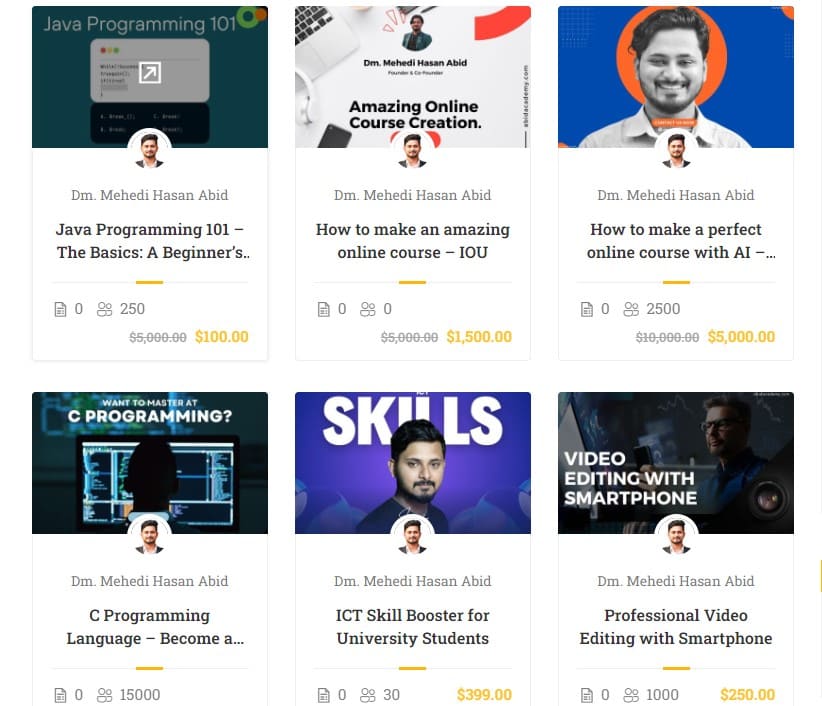
How to Create an Online Course in 2023: A Step-by-Step Guide
As you landed on this blog that means you wish to teach online or I assume you have an idea that you want to shape as an online course. Creating an online course is a great way to share your knowledge and expertise with the world, and it can also be a very profitable business venture.
Did you know that the online course market is expected to reach $350 billion by 2025? That’s a lot of money! If you have knowledge and expertise that you can share with others, creating an online course could be a great way to make some extra money.
Table of Contents
I am Mehedi Hasan Abid, and I have published 10+ online courses on different platforms including Udemy, and over 3+ years of experience as a content specialist. In this blog post, I’m going to share with you my step-by-step guide on how to create an online course in 2023.
Step 1: Find Your Niche and Target Audience
The first step in creating an online course is to choose a topic that you’re passionate about and knowledgeable about. It’s also essential to choose a topic that has a demand in the market.
So how do you choose a topic that’s both passionate and profitable? Here are a few tips:
- Think about your skills and expertise. What are you good at? What do you know a lot about?
- Consider your interests. What are you passionate about? What do you enjoy learning about?
- Do some market research. What are people searching for online? What are they asking questions about? What problems are they trying to solve?
Once you’ve chosen a topic, it’s time to identify your target audience.
- Who are you trying to reach with your course?
- What are their needs and pain points?
Many people made the mistake in the first place without prioritizing setting the target audience. But from my experience, I can ensure that this is one of the parts you need to research and brainstorm. Ask yourself, ‘Who is your genuine audience that is ready to buy your course?” Think! Do research and start preparing the rest of the following content.
Once you understand your target audience, you can tailor your course content to their specific needs.
Set Clear Learning Objectives
With your course topic in mind, it’s time to set clear learning objectives. Learning objectives are the foundation of your course, guiding both you and your students throughout the journey. What do you want your students to achieve by the end of the course?
Ensure your objectives are specific, measurable, achievable, relevant, and time-bound (SMART). This helps you create focused content and allows students to track their progress effectively.

This picture shows you the demo that how I set the learning objective for the learner of my course “How to make a best-selling online course with AI”.
Step 2: Create an outline for your course
Once you know what you’re going to teach and who you’re going to teach it to, you need to create an outline for your course. This will help you to structure your course content and ensure that it’s well-organized and easy to follow.
When creating your outline, be sure to include the following elements:
- Course introduction: This section should introduce your course, including the topic, your target audience, and the learning outcomes.
- Course modules: Each module should focus on a specific topic or skill. Be sure to include a variety of learning activities in each module, such as videos, lectures, quizzes, and assignments.
- Course conclusion: This section should summarize the key takeaways from your course and provide students with the next steps.
- Course promotional content: This is one of the mandatory tasks that many instructors avoid. Put yourself in a learner’s shoes. Why in the first place I am going to enroll in your course? Then design your promotional video as a hook to attract an audience to enrol in your course.
Gather Course Materials
To create a comprehensive course, you’ll need a variety of course materials. These might include research materials, reference books, and academic papers. However, after the innovation of open AI, many tools are available that can help to gather information or research your course content much better and make it real quick such as Bard, ChatGPT, Bing, and many more.
Multimedia elements can greatly enhance engagement, so think about how you can integrate images, videos, and audio effectively. I would recommend map at this phase I have done the mapping for my course like
- How I am going to talk. Professionally or in a conversation tone?
- What type of design I am going to use in my lecture content?
- How I am going to do my editing
And the rest of the things just map in a pen or paper or any electronic media that makes your progress faster and smoother.
Step 3: Develop your course content
Once you have an outline, you can start developing your course content. This may involve creating videos, writing lectures, creating workbooks, and developing other learning materials.
When developing your course content, be sure to keep your target audience in mind. Use language that is clear and easy to understand, and provide plenty of examples and illustrations.
You should also use a variety of multimedia elements in your course content, such as videos, images, and audio recordings. This will help to keep your students engaged and make your course more visually appealing.
Now, it’s time to bring your course to life with engaging content. Develop high-quality video lectures that capture your students’ attention. Write informative, engaging text-based content, and design interactive quizzes and assessments to test their knowledge.
Remember, engagement is key in online learning. Make your content as interactive and enjoyable as possible.
Recording for video lessons
Creating compelling video content is a crucial aspect of online course creation. Whether you’re delivering lectures, demonstrations, or tutorials, the quality of your recordings matters. Here’s how to excel in the recording phase:
- Selecting Equipment: Invest in a good-quality microphone, camera, and lighting setup. High-definition video and clear audio are essential for engaging content.
- Scripting and Rehearsing: Before hitting the record button, prepare a script or outline. Practice your delivery to ensure clarity and coherence in your presentations.
- Recording Environment: Choose a quiet and well-lit space for recording. Consider using a green screen for a professional touch and the ability to add different backgrounds in post-production.
- Screen Recording: If your course involves software demonstrations, screen recording software is a must. Tools like OBS Studio, Camtasia, or ScreenFlow can capture your screen activities effectively.
Which recording method you choose will depend on the type of course you are creating. Efficient recording sets the foundation for high-quality course content.
Video Editing for online course
Once you’ve recorded your content, the editing phase is where you refine and polish it to perfection: Once you have recorded your course content, you need to edit it. This involves removing any mistakes, adding music or sound effects, and creating a polished and professional product.
- Cutting and Trimming: Remove any unnecessary segments, mistakes, or long pauses from your video and audio recordings. Keep the pacing engaging.
- Adding Visuals: Enhance your content with graphics, text overlays, and animations. Visual aids can clarify concepts and retain student interest.
- Audio Enhancement: Ensure audio levels are consistent and free from background noise. Add music or sound effects when appropriate, but don’t overdo it.
- Transitions: Use smooth transitions between scenes or segments to maintain a cohesive flow in your videos.
- Quality Control: Watch your videos multiple times to catch any errors or inconsistencies. Ensure that all visual and audio elements align with your course objectives.
- Accessibility: Consider adding subtitles or closed captions for accessibility. This improves the learning experience for all students, including those with hearing impairments or non-native speakers.
Familiarize yourself with video editing software like Adobe Premiere Pro, Capcut, Camtasia, Final Cut Pro, or simpler tools like Adobe Rush or iMovie. Effective editing not only makes your content more engaging but also demonstrates your commitment to delivering a top-notch learning experience.
By paying careful attention to the recording and editing phases, you can create online course content that is not only informative but also visually appealing and engaging for your students. If you are not comfortable editing your course content, you can hire a professional video editor or audio editor to do it for you.
The most optimized to create video lessons
What if you are currently on your budget? Is it mandatory to have a good-quality microphone, camera, and lighting setup? Also, the OBS studio is free but Camtasia is paid, For any high-quality software or recording or editing that is paid then what can you do?
Here, my dear friend I would say you don’t need fancy items or professional items to create an online course, however having them is a blessing. Also, it’s not mandatory to show face in the online course video lessons however visual appeal of the instructors creates more engagement in the video lessons.
If you have a mobile phone and laptop that is enough for creating video lessons for your online course. First of all design all of the lecture content with Microsoft PowerPoint or Google slides or using any medium just create lecture content and then export them as images for instance you have to design a lecture content named Introduction to Data Data Science and that is Lecture 1. So, you need to export all of the slides in lecture 1 as images.
Now, by keeping the lecture content in front of you on your laptop. Grab your mobile phone search the audio recording options and start recording your voice only. And deliver the lecture content that is in front of you. Please don’t read out from the lecture content use delivery style as you are teaching someone in front of you.
Now, Download cap cut software on your computer or any other video editing software free just to trim your unnecessary recording and merge it with your lecture content.
No matter what methods you follow to develop your content for your online lesson, You must have to follow a few guidelines and quality standards. However, different LMSs have different quality standards but 70% of them are common. So, focus on your content knowledge and outlook your course will rock.
Step 4: Choose a learning management system (LMS)
A learning management system (LMS) is a platform that allows you to deliver your online course to students. There are many different LMS platforms available, so it’s important to choose one that is right for your needs.
When choosing an LMS, consider the following factors:
- Features: What features are important to you, such as video hosting, quizzing, and discussion forums?
- Ease of use: How easy is the LMS to use for both you and your students?
- Pricing: What does the LMS cost?
Considering all facts I would recommend Udemy can be the perfect choice for you. They have all kinds of facilities you don’t need to spend anything except the time.
Do you need a website to host your course?
Having a website is a great asset where you can host yourself. However, that comes with lots of time, money, and management issues. But there is also a plus point you can have all of your revenue all by yourself. But if you choose any LMS platform that I mentioned earlier like Udemy you need to share the percentage with them and that is huge. And everything will not be in your hands.
To attract and enroll students, you’ll need a dedicated course website. Create a compelling landing page that highlights the benefits of your course. Customize it to reflect your branding and integrate secure payment gateways for enrollment. Your website is your storefront, so make it appealing and user-friendly.
You can build a website in several ways to host your online course. You can hire a few people to develop it yourself from scratch or you can easily develop by yourself through WordPress or Wix. They have a very good customize option and well plugin structure which will help you easily develop any LMS site. Also, you can purchase any online LMS themes from the theme forest. I did it for myself however I have very good technological knowledge so I have to design the front end of my website. You may check out the course page of Abid Academy.

Step 5: Market and launch your online course
If you have submitted your course on an existing LMS platform like Coursera, Udemy then you don’t need to worry based on your market demand LMS platform will do the marketing and they will also share your link so that you can promote and sell your course to go extra miles of earning. Or else if you have created a website to promote and sell your course. Then you can follow the methods below.
Once you’ve produced your course materials, you need to market and launch your online course. This may involve creating a landing page, running ads, and promoting your course on social media.
When marketing your course, be sure to highlight the benefits of your course and what students will learn. You should also create a strong call to action, such as “Enroll now!” or “Learn more.”
Step 6: Promote and sell your online course
Once you’ve launched your course, you need to continue to promote and sell it. Your course won’t sell itself. Develop a comprehensive marketing strategy that includes promoting your course on social media, utilizing email marketing, and even considering paid advertising.
Building a strong online presence is crucial in attracting your target audience. This may involve running ads, writing blog posts, and guest blogging on other websites. You can also offer discounts and promotions to encourage people to enroll in your course.
Step 7: Create a community around your online course
Creating a community around your online course is a great way to keep students engaged and coming back for more. You can create a community by setting up a discussion forum, hosting live Q&A sessions, and creating a private Facebook group for your students.
When creating a community, it’s important to be active and engaged. Respond to student questions and comments promptly, and participate in discussions. You should also encourage students to interact with each other.
Step 8: Collect feedback and improve your online course
It’s important to collect feedback from your students so that you can improve your online course. You can collect feedback by sending out surveys, conducting interviews, and reading student comments and reviews.
Once you’ve collected feedback, take the time to review it carefully. Look for common themes and areas where you can improve your course.
Step 9: Scale your online course business
Once you have a successful online course, you can start to scale your business. This may involve creating new courses, expanding your target audience, or offering additional services.
Here are a few tips for scaling your online course business:
- Create new courses. If you have the time and resources, you can create new courses to expand your offerings.
- Expand your target audience. Consider expanding your target audience to reach new students. For example, if you currently teach a course on how to start a blog, you could expand your target audience to include small business owners and entrepreneurs.
- Offer additional services. You can also offer other services to your students, such as one-on-one coaching or group mentoring.
As your online course gains attention, explore opportunities to scale. Consider expanding your course offerings, collaborating with other experts, and investing in marketing to fuel growth.
Analytics and Tracking
In the world of online education, data is your ally. Analytics tools provide valuable insights into your course’s performance. Keep these points in mind:
- Engagement Metrics: Track how students engage with your content, such as video views, quiz completion rates, and time spent on lessons.
- Completion Rates: Analyze the percentage of students who finish your course. If it’s low, consider adjustments to improve retention.
- User Feedback: Encourage students to provide feedback, and use it to enhance your course. Their insights can be invaluable.
- Marketing Effectiveness: Monitor the success of your marketing efforts through website analytics and conversion tracking.
Data-driven decision-making can help you refine your course and marketing strategies for better results.
Ensure Ongoing Support
Providing excellent customer support is vital for your course’s success. Be prepared to handle technical issues and assist students when they encounter challenges. Maintain your course with regular updates to keep it relevant.
Testimonials and Social Proof
Testimonials and social proof are powerful tools for attracting new students. Here’s how to leverage them:
- Collect Testimonials: Encourage satisfied students to share their positive experiences. Highlight their stories and feedback on your course website.
- Showcase Achievements: Display any awards, recognitions, or partnerships related to your course. It adds credibility and trustworthiness.

Positive reviews and social proof can help potential students overcome any hesitations and commit to your course.
Success Stories
To inspire you on your journey, here are a few success stories of individuals who started from scratch and built thriving online courses. Their journeys reflect the immense potential in the world of online education.
Challenges and Solutions
I won’t sugarcoat it; creating and managing an online course can come with its challenges:
- Technical Issues: Technical glitches can happen. Have a plan in place to address them promptly and provide support to affected students.
- Competition: The online education landscape is vast. To stand out, focus on delivering unique value and marketing effectively.
- Content Updates: Keep your course content fresh and up-to-date. Outdated information can deter students.
Navigating these challenges requires adaptability, resilience, and a commitment to delivering the best possible learning experience.
Online Teaching Jobs
Aside from creating your course, you can also explore opportunities for online teaching jobs. Many platforms are constantly on the lookout for skilled instructors. Consider platforms like Udemy, Coursera, or even private tutoring opportunities.
Success in online teaching often involves a mix of expertise, engaging teaching methods, and effective communication.
Conclusion
Creating an online course in 2023 is an adventure filled with possibilities. Remember, it’s not just about sharing knowledge; it’s about making a positive impact on your students’ lives. By embracing challenges, staying adaptable, and continually refining your course, you can be part of the exciting future of online learning. and it can also be a very profitable business venture. By following the steps in this guide, you can create a successful online course that helps you to achieve your goals.
If you are considering creating an online course, I encourage you to plan today. Think about your topic, target audience, and learning objectives. Once you have a good plan in place, you can start developing your course content and marketing your course to students.
Creating an online course can be a lot of work, but it is also a very rewarding experience. By sharing your knowledge and expertise with others, you can make a difference in the world and build a successful business.
FAQs
What is the best topic for an online course?
The best topic for an online course is something that you are passionate about and knowledgeable about. It is also essential to choose a topic that has a demand in the market.
How much does it cost to create an online course?
The cost of creating an online course can vary depending on several factors, such as the length of your course, the type of content you create, and the platform you use to deliver your course. However, it is possible to create an online course on a budget.
How do I market and sell my online course?
There are several ways to market and sell your online course, such as creating a landing page, running ads, and promoting your course on social media. You can also offer discounts and promotions to encourage people to enrol in your course.
How do I create a community around my online course?
You can create a community around your online course by setting up a discussion forum, hosting live Qu0026amp;A sessions, and creating a private Facebook group for your students.
How do I collect feedback and improve my online course?
You can collect feedback from your students by sending out surveys, conducting interviews, and reading student comments and reviews. Once you’ve collected feedback, take the time to review it carefully. Look for common themes and areas where you can improve your course.
u003cstrongu003eHow do I create a training course?u003c/strongu003e
Creating a training course involves identifying needs, setting clear objectives, and developing tailored content. Choose the right delivery method and use a learning management system (LMS) for tracking. Assess trainee progress, provide certifications, gather feedback, and continuously improve your training to meet specific organizational goals.
u003cstrongu003eHow do I create an online course online?u003c/strongu003e
Creating an online course starts with choosing a topic and setting clear objectives. Plan your content, gather materials, and select a platform. Develop engaging content, build a course website, and market your course effectively. At launch, ensure everything is ready, gather feedback, and scale your course over time.
u003cstrongu003eHow can I create an online course for free?u003c/strongu003e
To create a free online course, use tools like Google Docs for content and free screen recording for videos. Host your course on free or low-cost learning management systems (LMS) and use royalty-free resources. Market through social media and free email marketing. Consider free website builders for your course landing page.
u003cstrongu003eHow do I create a simple online course?u003c/strongu003e
Start by choosing a basic topic and setting clear learning objectives. Create concise content through short videos or text tutorials. Choose a user-friendly platform to host your course and create an effective landing page. Market your course, provide basic support, and focus on simplicity to get started.




4 Comments